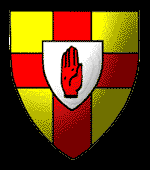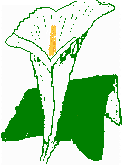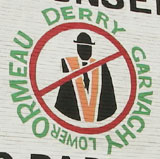
Symbols Used in Northern Ireland
|
Image |
Details |
 |
Title: Colours as Symbols Description: The colours 'green' and 'green, white and orange' are closely associated with Nationalism and Republicanism in Northern Ireland. Green has been a traditional symbolic colour for Ireland and has been the basis for a number of flags (see for example the Leinster flag). The colours green, white and orange are important to Nationalists and Republicans because they form the Tricolour of the Republic of Ireland. |
 |
Title: Acronyms as Symbols Text: 'IRA' Description: The acronyms, or initial letters, of the larger Republican paramilitary groups, such as IRA (PIRA), INLA, etc., were often to be found painted on walls in Catholic working-class areas. The initials were also incorporated into many other symbols such as flags and murals. |
 |
Title: Dates as Symbols Text: '1916' Description: As was the case in Protestant areas, dates often appeared in Catholic areas either on their own or incorporated into other symbols such as murals, slogans, or flags. |
 |
Title: Slogans as Symbols Text: 'Brits Out' Description: Slogans such as 'Tiocfáidh ár Lá', 'Remember 1916', and 'Brits Out' - referring to British soldiers - were to be found painted on walls in Nationalist and Republican areas. |
 |
Title: Crest of the O'Neills Description: The Crest of the O'Neills represents the nine counties of the province of Ulster. It is said that King Hugh O'Neill adopted the Red Hand after seeing it on the Monasterboice high cross, representing the hand of God. There have been alternative explanations for the use of the Red Hand symbol. The O'Neills were the most resilient of all the Irish Gaelic Clans in resisting English invasion. |
 |
Title: Celtic Emblem Description: Irish Nationalists see themselves as descendants of a Celtic past. The Celts lived on the island of Ireland since around 500 BC, and nurtured a very strong Gaelic culture (with its own language, sport, music and mythology) which is still widely used to this day. The mythological warrior, Cú Chulainn is character from Celtic mythology. Distinctive Celtic art can be seen in a multitude of different forms. The Celtic traditions that had withstood the Viking and Norman invasions became overwhelmed in the seventeenth century by the English invasions and plantations. |
 |
Title: Crest of the United Irishmen Description: Widely seen as the birth of Irish Republicanism, the Society of the United Irishmen was a Republican movement founded in 1791 in Belfast by the city's leading merchants and intellectuals. Their movement was based upon the ideals of liberty, equality and fraternity espoused by the French revolution of 1789. Led by a young Dublin Barrister by the name of Theobald Wolfe Tone, the society desired an Ireland free from the authority of England and its sectarian Protestant ascendancy, thus embracing the Protestant, Catholic and Dissenter traditions. The United Irishmen's Rebellion of 1798 failed facing the impossible odds of seasoned troops and British espionage. |
 |
Title: Emblem of the Ancient Order of Hibernians with US flag and Irish Tricolour in the backgound. Text within image: 'AOH', 'IAOH' Description: Often regarded as the Catholic counterpart to the Orange Order, the Ancient Order of Hibernians (AOH) was founded in the USA in 1838. The word 'Hibernia' comes from the old Roman name for Ireland. AOH members parade with banners depicting their Catholic, Nationalist and Celtic heritage. The traditional AOH parade days each year are 15 August, the Feast of the Assumption, and St. Patrick's day on 17 March. |
 |
Title: Easter Lily Description: This symbol is associated with the 1916 Easter Rising in Dublin, due to the seasonal decoration in churches during that period. It is worn as a flower of remembrance for those who gave their lives for the cause of Irish independence. When the Irish Republican Army (IRA) split in 1970 to form the Provisional IRA and the Official IRA both organisations continued to use a paper representation of the Easter Lily in their separate commemorations. Official IRA members wore an Easter Lily with a self-adhesive backing and hence became known as 'the Stickies', while the Provisional IRA supporters secured theirs with a traditional pin (their nickname 'the Pinheads' didn't last). |
 |
Title: Green Ribbon Description: The Green Ribbon was worn in support of 'Saoirse' a Republican organisation which campaigned on behalf of Republican paramilitary prisoners. In the past Saoirse lobbied for the recognition of political status for Republican prisoners, demanded the release of all political prisoners of the conflict, and supported the 1998 Good Friday Agreement. It received strong support from the USA. |
 |
Title: Orangeman Symbol Description: This symbol began to appear in Nationalist areas where Loyal Order marches were proving controversial. The symbol combines a representation of an Orangeman and the traffic symbol for 'not allowed'. It is mean to represent the fact that the Orange Order is not welcome. Following the use of this symbol a Loyalist version began to appear. |
 |
Title: Policeman Text: 'Disband the RUC' Description: The issue of policing, and in particular the acceptability of the Royal Ulster Constabulary (RUC) in Catholic areas, was high on the political agenda for the many years. The RUC, which was 92 per cent Protestant, was replaced by the Police Service of Northern Ireland (PSNI) on 4 November 2001. This symbol and similar ones, all referred to the fact that many Nationalists found the RUC unacceptable. The symbol of the RUC officer was often painted with an 'orange sash' (collarette) as in this example. This referred to the fact that many officers were members of the Orange Order. |
CAIN
contains information and source material on the conflict
and politics in Northern Ireland. CAIN is based within Ulster University. |
|
|
|||
|
Last modified :
|
||
|
| ||
